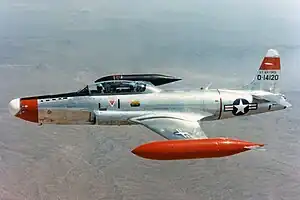Lockheed NT-33A
For several decades, the Lockheed NT-33A played a significant role in supporting various Department of Defense projects as an in-flight simulator. The NT-33A possessed versatile capabilities, serving as a valuable tool for studying the flight characteristics, cockpit displays, control sticks, and flight control design of multiple aircraft models, such as the X-15, A-10, F-15, F-16, F/A-18, F-117, and F-22. Additionally, the NT-33A was employed for training numerous test pilots from the U.S. Air Force and Navy, in addition to its research contributions.
| NT-33A | |
|---|---|
 | |
| NT-33A in flight. | |
| Role | In-Flight Simulator |
| Manufacturer | Lockheed |
| First flight | 1957 |
| Introduction | 1958 |
| Retired | 1998 |
| Status | Retired, in storage at the National Museum of the United States Air Force. |
| Primary user | United States Air Force |
| Produced | 1957 |
| Number built | 1 |
| Developed from | Lockheed T-33 |
During the late 1950s, the NT-33A underwent a significant transformation from a standard T-33 trainer with the nose of an F-94. This modification turned it into a versatile platform capable of simulating the flight characteristics of various aircraft. The advanced programming implemented in the NT-33A allowed for accurate replication of flight profiles from different aircraft types. Moreover, the NT-33A featured an innovative "artificial feel" system that reproduced the unique characteristics of the stick and rudder controls found in the simulated aircraft. By manipulating the controls in the front seat, the evaluation pilot could observe the NT-33A's mirrored response to the simulated aircraft. To ensure safety, a safety pilot occupied the rear seat, equipped with standard controls to take over in the event of computer malfunctions or excessively challenging simulation scenarios.
The responsibility for modifying, operating, and maintaining the NT-33A was entrusted to the Calspan Corporation, formerly known as the Cornell Aeronautical Laboratory. Over a span of 40 years, the NT-33A played a vital role in conducting numerous research programs across the nation under Calspan's guidance. The NT-33A concluded its last research project in April 1997 and was subsequently placed on display at the National Museum of the United States Air Force in August 1997, before being moved into storage.
Timeline of development
| ? | The NT-33A was originally constructed by Lockheed at Burbank, California, USA as a T-33A-1-LO. | |
| 1957 | The NT-33A was loaned to Calspan Corporation in Buffalo, NY. It underwent a conversion process to transform it into an NT-33A, which included the addition of an F-94 nose. | |
| By November 1986 | The NT-33A was later transferred to the 6512th Test Squadron at Edwards Air Force Base, CA. | |
| 22 April 1997 | Transferred to Air Force Flight Test Center, Edwards AFB, CA.
The final assignment was at Edwards before hand over to USAF Museum. At the time it was the oldest active aircraft in the USAF inventory. | |
| April 1997 | Following its service at Edwards Air Force Base, the NT-33A went on a ferry flight and was finally delivered to the National Museum of the United States Air Force at Wright Field in Dayton, OH. | |
| August 1997 | Upon its delivery to the National Museum of the United States Air Force, the NT-33A was placed on display for visitors to view. | |
.jpg.webp) NT-33A at the national Museum of the United States Air Force |
Specifications
Data from Lockheed Aircraft since 1913[1]
General characteristics
- Crew: 2
- Length: 38 ft 2 in (11.63 m)
- Wingspan: 38 ft 10.5 in (11.849 m)
- Height: 11 ft 8 in (3.56 m)
- Wing area: 234.8 sq ft (21.81 m2)
- Airfoil: NACA 65-213[2]
- Empty weight: 8,367 lb (3,795 kg)
- Gross weight: 12,072 lb (5,476 kg)
- Max takeoff weight: 15,062 lb (6,832 kg)
- Powerplant: 1 × Allison J33-A-35 centrifugal flow turbojet engine, 5,400 lbf (24 kN) thrust for take-off with water injection
- 4,600 lbf (20,461.82 N) maximum continuous, dry
Performance
- Maximum speed: 600 mph (970 km/h, 520 kn) at sea level
- Cruise speed: 455 mph (732 km/h, 395 kn)
- Range: 1,275 mi (2,052 km, 1,108 nmi)
- Service ceiling: 48,000 ft (15,000 m)
- Rate of climb: 4,870 ft/min (24.7 m/s)
References
- Francillon 1982, pp. 287, 293.
- Lednicer, David. "The Incomplete Guide to Airfoil Usage". m-selig.ae.illinois.edu. Retrieved 16 April 2019.
“ NT-33A". National Museum of the United States Air Force™. Retrieved 2023-09-20.
“ NT-33A". National Museum of the United States Air Force™. Retrieved 2023-09-20.
“Aerialvisuals". Airframes Database . Retrieved 2023-09-20.